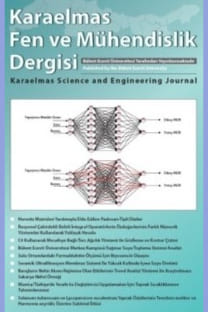Tek ve Çift Etkili Absorpsiyonlu Soğutma Çevrimlerinin Ekserji Yönünden Karşılaştırılması
Absorpsiyon, Soğutma, ECOP, Tek ve çift etkili
Exergetic comparison of single and double effect absorption cooling cycles
Cooling, Absorption, Single-Double effect, ECOP,
___
- Annamalai, K., Puri, IK. 2002. Advanced thermodynamics engineering, CRC Press LLC.
- ASHRAE Fundamentals Handbook. 2001. Chapter 1. Thermodynamics and refrigeration cycles.
- Avanessiana, T., Ameri, M. 2014. Energy, exergy, and economic analysis of single and double effect LiBr–HO absorption chillers. Energy Build., 73: 26–36.
- Bouaziz, Nahla, Lounissi, D. 2015. Energy and exergy investigation of a novel double effect hybrid absorption refrigeration system for solar cooling. Int. J. Hydrogen Energy, 40: 13849- 3856.
- Chua, HT., Toh, H.K., Malek, A., Ng, KC., Srinivasan, K. 2000. Improved thermodynamic property fields of LiBr-H2O solution. Int. J. Refrigeration, 23: 412-429.
- Cimsit, C., Ozturk, IT., Kincay, O. 2015.Thermoeconomic optimization of LiBr/H2O-R134a compression absorption cascade refrigeration cycle. Appl. Therm. Eng., 76: 105-115.
- Colorado, D., Rivera, W. 2015. Performance comparison between a conventional vapor compression and compression- absorption single-stage and double-stage systems used for refrigeration. Appl. Therm. Eng., 87: 273-285.
- Dincer, I., Rosen, MA. 2007. EXERGY, energy, environment and sustainable development, 1st ed., Elsevier Ltd.
- ISSN: 2146-4987
- Yayın Aralığı: 3
- Başlangıç: 2011
- Yayıncı: ZONGULDAK BÜLENT ECEVİT ÜNİVERSİTESİ
ALİ OSMAN KUŞAKCI, BERK AYVAZ, Emir BEJTAGİC
KEMAL BÜYÜKGÜZEL, Kıymet Senan COŞKUNCU, ENDER BÜYÜKGÜZEL, MELTEM ERDEM KÜÇÜK, CEYHUN KÜÇÜK
AHMET OCAK AKDEMİR, MUSTAFA GÜRBÜZ, ERHAN SET
MERT GÜRTÜRK, HAKAN FEHMİ ÖZTOP, Khaled AL-SALEM
Tiyosemikarbazon İçeren Vis-Dioksim Ligandının Ni II Kompleksinin DNA Etkileşimlerinin İncelenmesi
Burak COBAN, Cengiz SAĞLAM, Nursel ESER, İlknur BABAHAN
Orhan BÜYÜKGÜNGÖR, Çiğdem ALBAYRAK KAŞTAŞ, Serap UZUN, İsmet ŞENEL
Sinop İli İçin Rüzgâr ile Elektrik Üretiminin Potansiyeli ve Çevresel Etkilerinin Değerlendirilmesi
Karadeniz’de Meydana Gelmiş Deniz Fırtınalarının Sayısal Modellenmesi
n-Mertebeden Türevlenebilir Quasi-Konveks Fonksiyonlar Yardımıyla Eşitsizlikler
SEB’e Bağlanan Tekrarlı Peptid Dizilimlerinin REMD Çalışması
